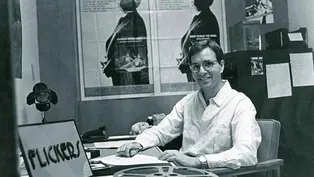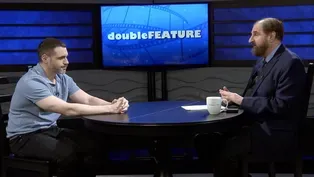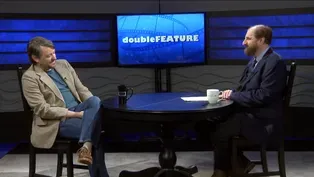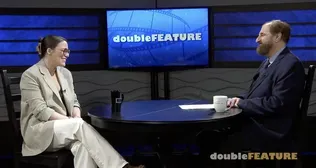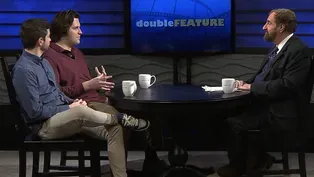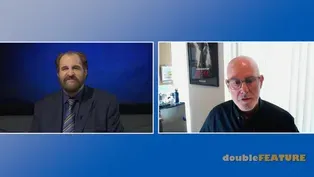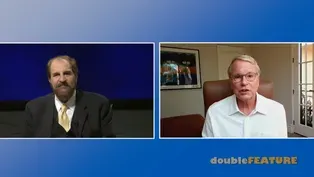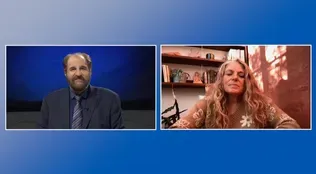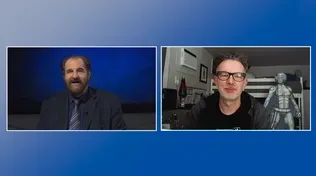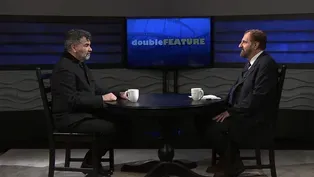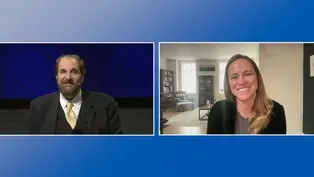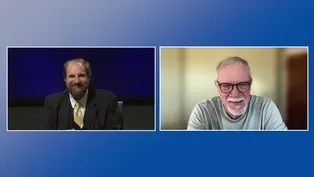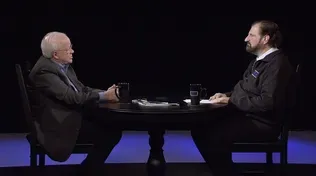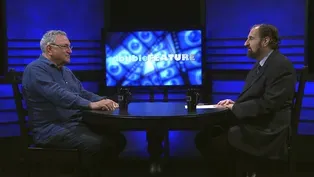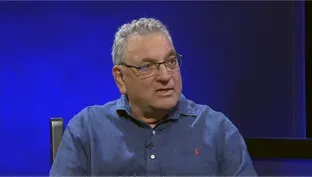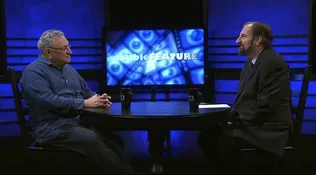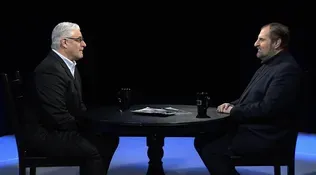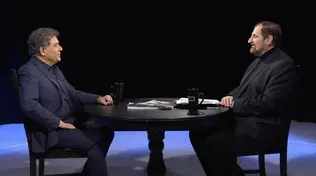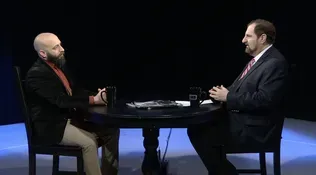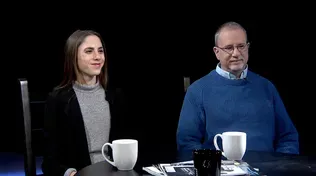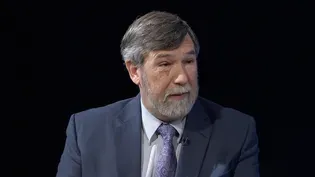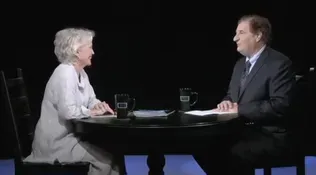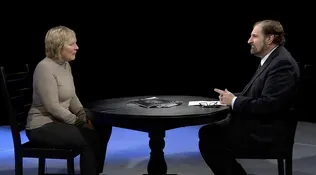
Interview with Joe Johnston
Clip | 41m 56sVideo has Closed Captions
Steven Feinberg interviews directer/producer Joe Johnston.
Steven Feinberg, executive director of The Rhode Island Film and Television Office, interviews director/producer Joe Johnston, known for his work on such films as "Honey, I Shrunk the Kids," "Jumanji," "October Sky," and many more.
Problems with Closed Captions? Closed Captioning Feedback
Problems with Closed Captions? Closed Captioning Feedback
doubleFEATURE is a local public television program presented by Rhode Island PBS

Interview with Joe Johnston
Clip | 41m 56sVideo has Closed Captions
Steven Feinberg, executive director of The Rhode Island Film and Television Office, interviews director/producer Joe Johnston, known for his work on such films as "Honey, I Shrunk the Kids," "Jumanji," "October Sky," and many more.
Problems with Closed Captions? Closed Captioning Feedback
How to Watch doubleFEATURE
doubleFEATURE is available to stream on pbs.org and the free PBS App, available on iPhone, Apple TV, Android TV, Android smartphones, Amazon Fire TV, Amazon Fire Tablet, Roku, Samsung Smart TV, and Vizio.
(upbeat music) - Hi, I'm Steven Feinberg, Executive Director of the Rhode Island Film and Television Office.
Our guest tonight is a fantastic filmmaker.
He's won an Academy Award for visual effects for "Raiders of the Lost Ark."
He designed "Star Wars," he did "Captain America" as a director, and many other films.
And he's a friend I've known for, I hate to say it, probably 40 years now.
Joe Johnston, welcome to "doubleFEATURE."
- Thank you.
- Joe, you grew up where?
Austin, Texas?
- I was born in Austin, but my family moved to Corpus Christi when I was six.
So I really grew up in Corpus Christi, and then we moved from there to California when I was 14.
- Oh, okay.
So did you always, did you always- - I consider myself a native Californian, just so you know.
- Okay.
Did you always have an affinity for drawing and art?
- I did.
My father was an artist.
He was a scenic artists for the live theater and television shows and stuff like that.
And I always, I sort of gravitated toward art and, you know, things like literature and music.
I was no good at science or math, any of that stuff.
I have a completely, you know, that side of my brain is absent, so.
- Well, that's kinda interesting, 'cause even though when you look at your artwork, it feels maybe, I don't know, the designs feel like there's some sense of science to your art.
I mean, everything is, you've designed the "Millennium Falcon" and design the "Death Star" and everything.
It feels like a sense of technology.
- I knew how to draw things or design things that looked like they work.
- [Steven] Okay.
(laughs) - That was the important thing.
You know, when I got outta school at Cal State Long Beach, I got a job at a, what at the time was a fairly prestigious industrial design studio where things actually had to work.
- [Steve] Oh.
- And about six months later I got this job at what was, wasn't even called Industrial Light Magic.
It was, you know, I answered this ad on the, I saw a flyer, "We're looking for artists and designers and model builders for a space movie."
And I got that job, and suddenly nothing had to work.
It just looked like it did have to work.
And that was such freedom.
- And when was that?
Like 1976 or '75?
- '75, August 12th, 1975 is when I was hired.
- Wow!
- And I worked there for about 10 years.
- Wow!
And were you influenced at all by, like, films like "2001?"
Had you seen all those science fiction films?
- I had seen a lot of science fiction films.
You know, the first film I ever saw, and I think I was probably seven years old, was the "Attack of the 50 Foot Woman."
- [Steve] I dated her.
(both laughing) - Who didn't?
- (laughing) Right.
- But, you know, it wasn't so much, I mean, I loved films of course.
It wasn't so much science fiction and later it wasn't so much visual effects.
You know, a lot of people think that I'm a visual effects artist, I'm not.
I'm a designer.
My designs are used in visual effects films.
But I'm not a visual effects person really at all.
I still consider myself a designer.
- So when you were going to college, you know, to design, what was in your head?
I know you got this opportunity for film, but what was in your head before that?
What were you thinking you would, were you thinking you were going to design cars?
Or what was in your brain?
- I was thinking I was gonna get a job at a design firm and, you know, where you design a variety of things, and I did.
I got this job at a place called Chuck Pelly Design Works, which was a great place to work, but he was up in the Malibu Hills and I was living in Long Beach so I had a 90 minute commute, which was no fun.
- [Steven] Right.
- In the Volkswagen Bug that sometimes started and sometimes didn't.
But, you know, while I was there, I think I designed a water softener, I designed some bus seating for Roar Industries.
And I talked to one of the guys there who he'd been working for Chuck for 10 or 12 years.
And I looked at what he was doing.
He was designing the clip that holds a ballpoint pen in your pocket.
- Oh, wow.
- You know?
And I'm looking over his shoulder thinking, "Is this what my future's gonna be?
You know, I can't imagine doing this."
I said, "How long have you been working on this?"
He said, "About four months."
- Oh, wow.
- I'm thinking, "Oh my God."
So when the job for "Star Wars" came up, I jumped.
- Had you ever heard about the Rhode Island School of Design?
Was that ever an interest that you might have come to Rhode Island?
- I had heard of the Rhode Island School of Design.
In fact, a good friend of mine, Shelly Johnson, my cinematographer, his daughter went to RISD.
And yeah, and, so I had heard of it, but, you know, at that point I was pretty much a California boy.
- Right, right.
So George Lucas, was he the one who put out all the, I don't wanna call 'em flyers, but maybe they were.
- John Dexter, put them out.
- Oh, John did, yep.
- John Dexter had gone through the industrial design program at Cal State Long Beach two years before I did.
And he had gotten out and was already working in visual effects and had been hired by George.
So when John was looking for people to staff ILM with, he sent somebody down to Cal State Long Beach and had 'em put flyers up all over the windows and walls of the design department.
- And so what did you do?
You had to show your different designs and artwork to be, 'cause what was there?
Like a dozen of you to start out?
- There were, you mean at ILM or from Cal State Long Beach?
- Well, for ILM.
- Yeah, I was the 11th person hired at Industrial Light Magic.
And there were, I think there were three of us from Cal State Long Beach.
- How old were you?
Like 21, 22?
- 25.
- 25.
Yeah.
- [Joe] Yeah, I was one of the older ones.
- [Steven] Yeah.
(both laughing) - But, (laughs), so when he was looking for people to staff ILM with, you know, he sent somebody down there.
And what I found out later was I was the only person who applied for the job.
I went back to Cal State Long Beach, and I got Steve Galley and Ira McNabb who were in the design program, and I encouraged them to come up and bring their portfolios or whatever they had, but no one else applied for the job, so, you know, of course, that's why I got it.
- You're right, right, right.
You're in the moment.
I had Karen Allen here, and she was talking about, her first gig was "Animal House," and she was going to this actor's, you know, studio, and there was a flyer up about auditioning, and she was the only one that noticed it.
Everyone else walked by.
I said, "You were in the moment."
And then she ended up, you know, her career got launched that way.
So did you then moved over to Marin County from where you were in Long Beach?
- [Joe] After, well, during "A New Hope," I moved from Long Beach to North Hollywood.
- [Steven] Oh, North Hollywood.
- I had a 10 minute drive to work instead of an hour.
So that was good.
And then after "A New Hope," George invited a lot of us, not everyone, but a lot of us to move to Marin County.
- So "New Hope" was really, the pre-ILM was in North Hollywood?
- [Joe] It was in Van Nuys.
- [Steven] Okay.
- Yeah.
And as soon as we finished "A New Hope," that was right before the release date, a few weeks before the release date, Glenn Larsson, who was a TV producer, came in and he said, "I want all of you guys to move on to 'Battlestar Galactica.'"
So he leased the building.
He hired everyone, you know, to do the designs and the visual effects for that show.
And then I finished early because everything was designed, and I was the first one of that group to move to Marin County.
- Wow.
And what were your expectations moving?
Did you know that there was going to be a trilogy of "Star Wars?"
And did George, like, tell you about some of his other dreams of other projects?
- Not at the time.
We knew there was gonna be a trilogy after the success of "Star Wars," because George had said, "I've got other films that are already written," or he had stories that were written.
The scripts weren't written yet.
But, you know, the challenge was after the success of "Star Wars," we knew we had to do it one better, we had to improve on what we had done.
And that was a challenge.
And that continued to be the challenge for all the original trilogy films.
You know, after "Empire," it was "Return of the Jedi," which had more shots and more complicated shots than either of the other two films.
- Joe, where did you first see "Star Wars" on the big screen, like as a completed project?
Like, what theater were you in?
- I actually saw it at Grauman's.
- [Steven] Oh, in Hollywood.
- Yeah, we got some, I forget if somebody gave us, you know, passes or something, but there were several crew members who were allowed to go in.
We didn't have to wait in the lines that were around the block.
You know, they let us in the back door or something.
But that's the first time I saw it.
- Were you blown away when you saw how it looked with the audience reacting, sold out, crowded?
- It was amazing.
It really was amazing.
Because we had never seen, we had seen an earlier, it wasn't a rough cut, but it was a pretty much a finished cut, but it didn't have all the visual effects in it, didn't have the final music or the final sound effects.
It was very rough.
But even so, we knew this was gonna be something special, we just didn't know how special it was gonna be.
- That's unbelievable.
And then with the John Williams score, just taking it over to the top, right?
- Yep, oh, absolutely, as he did with all the "Star Wars" songs.
- Everything.
(laughing) Everything, everything he's ever done.
You know, it's kind of amazing that the group of guys and women, and there's... Are you directing right now the second season of the documentary, "Light & Magic?"
- [Joe] Yes, I am.
- So the first one was, this is a documentary about ILM, the creation of the Industrial Light & Magic, the history.
It was Lawrence Kasdan, right, who did season one?
- That's correct.
- And now you're doing season two.
What is the season two focusing on?
- Well, it's more the digital revolution.
And a lot of it is the prequel trilogy about- - Oh, okay.
Yep.
- How, you know, everything that had been learned in the interim and the fact that it was proven that you could do visual effects digitally.
You know, when "Jurassic Park" came out, I think that that was one of the things that told George, okay, now I'm ready to do the prequels and I have the technology available to do them the way I wanna do them.
- [Steven] Yep.
- It's a lot of that.
It's sort of the digital revolution, it's the prequels.
It's where ILM is going next, which is really exciting.
- Can you share where ILM is going next?
- Can I do what?
- Can you share that with us where it's going next?
- Well, you know, it's always going somewhere.
- (laughing) Right.
- But it involves a lot of motion capture.
It is, of course, everything is digital from here on out.
But you have to watch episode three of the second season, and then I'll tell you all about it.
- Oh, good.
Are there gonna just be two seasons or is it gonna, will there be a third season as well?
- It's hard to say at this point.
You know, the second season is taking ILM from the early '90s to the present day and beyond.
So I don't know that there'll be material for a third season at this point.
- Gotcha.
Okay.
That's what I was wondering.
So the original trilogy used a lot of model work, puppetry, and so much of that stuff stands the test of time.
I had Doug Trumbull here one time, and we were talking about model work versus CGI and how that sometimes it's the models that actually stand up, because there's, I guess a physicality to them or a texture to them.
And sometimes the CG doesn't stand up because our eyes are trained and they're educated in different ways.
And we're always evolving.
Do you find that as well?
- I do, I think that, you know, the digital revolution allowed a filmmaker to put anything he or she wants on the screen.
But that doesn't mean that they should, you know, I mean, you can do anything.
But the interesting thing with models and with something that, you know, you could hold in your hand, the tactile thing is that you had to build it and then you had to shoot it, and you had to, you know, you had to have very creative people of course, involved in the process of doing that.
But with digital stuff, it's mostly the guy or the girl at the keyboard.
- Right.
- And so it's, I think it's slightly less a collaborative effort.
I mean, I'm not a digital person.
I don't understand, I mean, what I'm doing right here is about as deep as I get into a computer.
- (laughing) Right, right, right.
- You know, but I think that it definitely changes the process in a huge way.
- Right.
I remember as you were talking about, like "Jurassic Park," it was, Phil Tippet was supposed to do the models for the, you know- - [Joe] The stop motion.
- The stop motion, and then he became extinct, right?
It was the word I think that was used.
I don't know if it was Dennis Muren or someone said, "You're now extinct.
We're using the computer," which were fantastic.
But you also had Stan Winston's Giant T-Rex.
- Sure.
Yeah.
I mean, that's a combination of things like, you know, you can't have an animatronic dinosaur walking across the field like you can with the digital one.
So I think there's always a way to combine the different disciplines.
- Right.
- But any effect is just a tool to tell a story, and that's what we need to keep in mind.
You know, I don't like to go into a film and just get barraged with visual effects that are not really moving the story forward.
- I'm the same way.
I like characters that you care about, that you're grounded, and hopefully sometimes you won't even notice that you have visual effects because they're so- - [Joe] Yeah.
- Let me ask you this.
What was it like working on, if not my favorite, one of my favorite films of all time, "Raiders of the Lost Ark?"
What was that like, that experience?
And when did you become a part of that, that show?
- Well, you know, when George wasn't doing a "Star Wars" film, we had an opportunity in between to do other things.
I mean, and, you know, "Raiders of the Lost Ark" was a Lucas Spielberg production.
So George naturally wanted one of the guys to, you know, move on to that at ILM.
But, you know, my involvement with "Raiders" was the visual effects.
It didn't involve any live action really.
And, you know, there were some wonderful effects in "Raiders," especially toward the end, the opening of the ark sequence.
You know, we did break some new ground there, but it was the effects in "Raiders," I think, that they wanted to fit the kind of story that it was, in a way they felt a little bit old fashioned, purposely old fashioned, because the story was taking place in, you know, 1936 or whatever it was.
So I'm glad that we didn't have digital effects in 1981 when we did that show, 'cause it would've, I think it would not have fit as well with the storytelling at the time.
- The ending with the, when the ghosts come out and it's the beautiful woman that turns into the skeleton face, was that all animated?
- No, it was, we had this actress that we made up, you know, with white makeup.
And we sort of built the shadows into her face and everything.
We photographed her, I think it was in front of black, and then we did this optical transition from her face to the skull face.
But it was all, I don't believe there was any hand animation in there.
The way we did the flying ghosts, that was with a puppet in a water tank trailing this material, some kind of like lacey, you know, cloth material behind it.
And we photographed that through the glass wall of a water tank.
- I remember that was very, that was something we hadn't seen before.
That was very grounded.
And well, that's why you won the Academy Award for that.
- You know, I did get an Academy Award for that.
I have to say that the show that we were up against, "Dragon Slayer," developed a whole new visual effects process, they called it Go Motion, where the animated puppet was moving while the shutter was open.
And that gave you- - The blur?
The blur.
- Blur.
It gave you blur.
But "Raiders," you know, being the film it was sort of swept the awards like a lot of films do.
And I always felt that for the visual effects, "Dragon Slayer" probably deserved the award.
(laughs) - Well, I'm sure the folks of "Dragon Slayer" would be very happy if you walked over to their home and gave them your award.
(laughs) - They've got, you know, that was Dennis Muren.
- [Steven] Oh, okay.
(laughs) - Dennis Muren has nine Academy Awards of his own.
He doesn't need mine.
- (laughing) He's gonna let you keep yours.
That's funny.
- Yeah.
- So, Joe, it was right around that time, "Raiders" was done, the "Star Wars" trilogy was done, the original, and then you are gonna go and go out and see the world, right?
And then George Lucas said, "Hey, I want you to go to film school," and offered to pay for your tuition and keep you on a somewhat of a salary.
And is that what sent you to USC Film School where you and I met?
- Oh, yeah.
After- - [Steven] Not that you needed film school.
- Well, actually, you know what?
Film school was, I was really glad I did go to film school because I realized that I knew a lot of stuff I just didn't have a context to put it into.
And the great thing about film school is that you are forced to go out and make a film which is one of the hardest things you can do.
You know, you're doing six different jobs, you know, including craft service and producing and directing and, you know, you're a wardrobe supervisor and all this stuff.
If you didn't have to show your dailies on Monday morning, you just wouldn't get out of bed to do it.
It's really tough things.
But yeah, George once said to me, this was before I was ready to leave ILM, but he said, "You know, anyone can direct a film."
And now when he offered me the job, offered me a USC for two semesters, I realized that he wanted to send me to USC to prove that anyone could direct a film.
(both laughing) But anyway.
- No.
- Yes, he did.
He was very generous.
He paid- - Anyone can direct a film, it could be bad.
(laughing) They can direct poorly.
(laughs) - Yeah, well, you know, a great crew can help a mediocre director make a fairly decent film.
It all depends on how willing you are to accept advice from people who know what they're doing, but- - Collaborating.
Collaborating.
- Collaborating.
Exactly right.
Exactly right.
But I did make a nine minute black and white film, which you may have seen.
- Was that the one on the rocks with a character, was a similar to a "Rocketeer" type of character?
- Well, no, he was a soldier.
- I remember it was on rock.
Was it on some kind of like rock formations?
- That's a desert.
- Huh?
Desert.
Was that the Joshua Street?
- We shoot it out near Randburg.
- I remember that.
- Yeah.
Anyway, I took that nine minute black and white film, and that was what essentially got me the job on "Honey, I Shrunk the Kids."
- [Steven] Oooh.
- [Joe] Because- - [Steven] Was that your three 10?
Was that your "3:10" film?
- That's my "3:10."
Disney had fired a director, Stuart Gordon.
- Yes, who directed a movie I did, "Fortress."
- Okay.
- He had done "Re-Animator."
- "Re-Animator."
- Correct.
- Yes.
And they were frantic to hire a director, to find director, and Tom Smith, who had been at ILM, who had run ILM, was now producing visual effects for Disney, And he said, "Get your reel and come down here and show Jeffrey Katzenberg," and I said, "I don't have a reel.
All I got is this nine minute black and white film at USC, non sync sound."
(Steven laughs) And he said, he said, "Okay, well, bring that."
But I met with him and I had read the script and I had a bunch of notes about the script that I thought were, you know, could improve it.
But I showed 'em this film and I walked out of there.
There were at a company retreat out in Palm Springs.
So I left the meeting thinking, you know, maybe I can get my old job back at Chuck Pelly's.
But I get a call a couple days later and Tom Smith says, "They want you to do the movie."
And so I went in to meet with Katzenberg again, and I said, "First of all, you gotta be kidding me.
You're hiring me on the strength of this student film."
(Steven laughs) And Jeffrey Katzenberg says, "No, we didn't really understand the film.
We just wanted to know that you knew where to put the camera."
- There you go.
(laughs) - I said, "Okay, go ahead."
- You did "Honey, I Shrunk the Kids," which was a tremendous success, right?
That was a great success for you.
And I think you did "Rocketeer," you did "Jumanji," you did... Can we jump into "Captain America," which was a, I think really kind of launched all these Marvel films.
What was that like?
- Good.
It was one of the early films and in the Marvel Cinematic Universe, but it was actually a Paramount film.
- [Steven] Oh, was it?
- Yeah, it was before Disney had bought Marvel.
In fact, I think it was the last Marvel film that was not a Disney picture.
But, you know, there was an earlier draft of that that was, the first half took place in the '40s, and the second half was modern day.
And I just said, "You know, if you're gonna tell the origin story of Captain America, you're only gonna get one chance to do that.
so let's make it, you know, let's..." Bookends are okay, present day bookends, that works.
But let's let the story be about, you know, the origin story taking place in the '40s.
And Kevin Feige agreed with me on that.
And so we were able to convince Marvel, which at the time was still a comic book company.
And they looked at the films as advertising for the comic books.
- [Steven] Wow!
- But they had a level of control that was sometimes difficult to get around.
But we had- - Were you dealing with Stan Lee?
Was Stan Lee the person who you were dealing with directly?
- No, Stan Lee at that point was, you know, basically retired.
And he would, he came in and did a cameo on all of the model shows.
- Right.
So he was more of a figurehead at this point?
- Yeah, we didn't, actually, he wasn't involved in the story or writing the script or anything like that.
But we had a great time with him, you know, coming in to play the general.
- Right.
Right.
- But, so we were able to convince Marvel to do the origin story.
And that's, I mean, I don't think I would've wanted to do the project otherwise.
You know, I really was, I mean, for one thing, I love that period, I love the '30s and '40s just for the designs and the- - And the costumes, the choices you made had a roughness in a great way.
It was a, I don't know, it was a masculine way of dealing with the look of "Captain America."
Because we've seen, there were other versions of "Captain America" that just looked goofy.
You made 'em feel like, cool.
- (laughs) That's my job, man.
- No, no, you did.
What about the casting of Chris Evans, and how did all that come about?
- [Joe] Well, Chris Evans had been in "Fantastic Four."
- Okay.
- And I think that he did not have the best experience in that project.
And it didn't do well.
And he was very, very reluctant to sign on to another superhero movie.
- [Steven] Yep.
- So we brought him into the art department.
We showed him all the visuals, you know, we talked him through the story.
Kevin Feige sort wined and dined him enough so he finally said yes.
And I think it was, you know, he was the obvious choice now.
He had to sign a nine picture deal- - [Steven] Wow!
- With Marvel that continued on when, you know, in the Disney years.
And I think that, you know, I ran into him at a restaurant in Hollywood not that long ago, and I said, "How's it going?"
He says, "I finally finished my nine-picture deal," (Steven laughs) and he was free.
- I'm a hundred years old now.
(laughing) I'm a hundred years old.
- Well, you know, they really cranked those things out.
- Yes.
Now, have you had no desire at all to jump back into that world?
- You know, it would depend on the project.
But, you know, a lot of people who like Marvel movies, I hear that, you know, there's something unique about "Captain America: The First Avenger," it was told in a different way.
And I think a lot of that has to do with the fact that it's the origin story.
But, you know, it would, it'd be tough.
I mean, regardless of the genre, I'm just always looking for a story, a great story that, you know, I haven't told before.
That's the thing.
You know, I don't wanna ever get sort of stuck into doing the same thing twice.
- Right, right.
- It took me a long time to sort of break out of the "Honey, I Shrunk the Kids" mold.
In fact, it was "October Sky"- - Great movie.
- That finally, you know, got me outta the sort of the kids fantasy films.
- Did you ever wanna do a "Star Wars" film?
Or is it, like you were saying that you didn't wanna go back and recreate the past or?
- Well, you know, again, it would depend on the story.
But those films, they seem to have gone a slightly different direction, you know, than the original trilogy that I worked on.
You know, I'm not opposed to anything as long as it's got a great story and it's, you know, I've got the resources to tell it.
- Yep.
What about, Joe, just with your legacy, I mean, the creation of not just like the, the "Star Destroyer" and the "X-Wing," and then you've, I remember you created the Rancor for "Return of the Jedi," and Boba Fett and Yoda.
And what's your, do you ever look back and say, my God, I had quite an impact the world of cinema and touch people's lives?
Ever, like, soaked that in?
- Well, you know, I didn't do it alone.
I had a lot of, it was a teamwork situation.
You know, and in fact, Phil Tippett designed the Rancor.
- [Steven] Oh, okay.
- Can't take credit for that.
He did it as a sculpture, you know, as a maquette.
But I was never working in a vacuum.
You know, especially on the original trilogy where it was, there were only like 50 of us who made those films.
- [Steven] Unbelievable.
- Well, the first one, especially "A New Hope."
And, you know, now there's, at ILM there's thousands, 2000, 3000 people all over the globe, you know, doing those visual effects, but... You know, it was, I see stickers on the back of cars, you know, the (laughs) Yoda, the Yoda silhouette and stuff like that.
You know, it's sort of fun.
I'm sort of glad they don't know who I am.
- (laughs) Do you ever watch any of like, shows like "Mandalorian" or "Boba Fett" or "Andor," or- - You know what?
I have to say, I have to confess, I've never seen any of those.
- Really?
Well, you should watch "Andor."
I loved "Andor" and- - Okay, if you say so.
- No, I say so, so you must do it.
We don't have a lot of time.
What was the experience of "Wolfman," Benicio del Toro, Anthony Hopkins?
What was that, you know, trying to- - You know, that was, again, that was a 911 call I got.
It was, that show was about to be directed by a different director who for whatever reason dropped out about three weeks from start of principal photography, so.
- That was Universal Studios, right?
That was a universal.
- That was universal.
- Yep.
- And I came in, you know, most of my prep, my three weeks of prep was making decisions because a lot of decisions had not been made down to details, like what kind of gun is this guy carrying?
Things like that.
So that was my period of prep.
But I had a great time on that show.
- Was that filmed in England?
Is that where you guys were?
England?
- It was out in the UK at- - Pinewood?
El Street?
- No, no, not El Street.
- Pinewood?
- Keep going, one more.
- Oh, what was the other one?
I know there's another one.
- Exactly.
- Right, the other one.
(laughs) - The other one.
I can't believe, I can't remember.
- I know, I can't either.
I will.
Sheridan.
- Shepparton.
- Shepparton.
- Shepparton.
- Shepparton.
- Shot the whole thing at Shepparton and out in the English countryside.
And I had a fantastic time with those guys.
- It looks great.
It looked great.
And Emily Blunt, right, Emily Blunt's in that too.
- Emily Blunt.
Emily Blunt was brilliant in that she knew how to match better than any actress I have ever seen, any actor I've ever worked with.
She knew how, you know, when he says that word, I'm holding the cup in my hand like this, and then when he finishes, I've sat it down, I think.
And I commented to her, I said, "Emily, I've never seen anybody match this good."
She says, "When the editor is having problems, he's gonna cut to me because I'm matching."
I said, "You're right."
She said, "I call that more EB time."
- (laughing) Right.
- I said, "Okay, you got it."
- Joe, when you're directing a film, do you like to rehearse actors beforehand or do you prefer not to rehearse?
- I don't particularly like to rehearse because for one thing, there's not always a lot of time to rehearse.
You know, these schedules are really down to the minute.
But a lot of times in my experience when I have rehearsed, something will happen in a rehearsal and you think, oh my God, that was great.
Can you just, remember what you did in rehearsal?
Can you do that?
It can't be repeated.
So, you know, that's why a lot of directors say, "Well, we're gonna rehearse on film."
So you shoot the first couple of takes, you know, as you work out the problems.
But I don't like to go into lengthy rehearsal sessions, 'cause I don't know, you lose a freshness to it sometimes.
- What about when you're blocking actors?
Do you come in with a full-blooded plan?
Or do you try to give your actors opportunities for them to move and do things on their own without necessarily your direction?
- Yeah, I come in with a shot list and a diagram of the scene.
I don't necessarily have to stick to it.
But, you know, the reason I do that is because if we start with a plan then we fine tune it, it's gonna be a lot easier for everyone, including the crew who's, you know, watching the first.
And I always do a master.
If you shoot a master, you're telling the cast and the crew what the scene is going to be, whether you use it or not, and then from then on you're moving into your coverage.
You know, but it just helps explain it to everyone.
- Yeah, but what about the actors doing certain things or moving in and out?
Do you say, hey, you're gonna sit here, you're gonna stand here, you're gonna walk over here?
Or do you try to allow your actors to organically come up and then you might sprinkle some other thoughts into their minds?
- I like to give them freedom within the plan.
- [Steven] Okay.
- But I like to design shots that we can use, shots that move.
And if you're gonna do a shot that move, if you're doing a shot where you know what's supposed to be happening in the scene and then the actor decides, well, I think I will walk over here, that's gonna screw everything up.
So, you know, I sort of nail it down.
And then within that framework, if they feel like I should pause here, I should turn to this person, you know, I let them do whatever they feel like they need to do.
We'll work out the, if that causes adjustments to be made, we'll work that out.
But I like to run a fairly tight ship without being a disciplinarian.
You know what I mean?
- Right, right.
You give 'em a certain amount of freedom, but you're still kind of controlling.
What about lenses?
Do you have particular lenses you like to use?
- You know what, I have a wonderful cinematographer.
His name is Shelly Johnson.
And Shelly and I will walk through the scene usually with stand-ins.
And then he will decide what lenses he wants to use.
And I leave that entirely up to him.
- Okay, I was seeing that, you know, there's certain directors use particular lenses often, and I guess Kubrick ended up creating some of his own lenses for, you know, and that he owned those lenses himself.
It's kind of interesting.
Well, what's next on the Joe Johnston film or TV front?
- I'm going to pitch a project to Imagine Documentaries.
I don't wanna say what it is yet because I don't want them to know yet, because I wanna spring it on 'em.
But I'm working on a project that has come and gone for the last five or six years.
And, you know, it went away because of COVID and then it came back.
But, you know, but then it went away because the schedule wasn't right.
And it's a science fiction based story.
But hopefully that's gonna be coming up in the next six months or so.
- Well, I wanna thank you for taking the time out of your super busy schedule.
I can't wait to see the second season of "Light & Magic."
And that's on Disney Plus, right?
- It is on Disney Plus, yes.
It's three episodes.
- [Steven] Three episodes.
- The first season was six episodes.
This is three episodes.
- Right, and I can't wait to see that because I love watching the season one.
And I just wanna thank you for your friendship and inspiring me and so many other people with your talent and being just a good guy.
And I wish you the very best of health and happiness always, my friend.
- Thank you, Steve.
You're too kind.
- All right, I look forward to talking to you soon.
- You better.
- Okay, pal.
Thank you so much.
- You're very welcome.
Thank you.
Thanks for having me.
The Legacy of George T. Marshall
Video has Closed Captions
Clip | 44m 58s | Remembering the founder of Flickers, George T. Marshall. (44m 58s)
Video has Closed Captions
Clip | 44m 59s | Steven Feinberg interviews director, writer, and actor, Tom DeNucci. (44m 59s)
Video has Closed Captions
Clip | 45m 2s | Interview with Alex Berard. (45m 2s)
Video has Closed Captions
Clip | 44m 59s | Steven Feinberg interviews First AD, Emma Barber. (44m 59s)
Interview with Chad Verdi Jr. and Paul Luba
Video has Closed Captions
Clip | 45m 31s | DoubleFeature shows films from around the world and takes viewers behind the scenes. (45m 31s)
Video has Closed Captions
Clip | 41m 15s | DoubleFeature shows films from around the world and takes viewers behind the scenes. (41m 15s)
Interview with Angela Peri and Lisa Lobel
Video has Closed Captions
Clip | 45m 25s | Interview with Angela Peri and Lisa Lobel (45m 25s)
Video has Closed Captions
Clip | 45m 45s | Interview with Jerry Ketchem. (45m 45s)
Video has Closed Captions
Clip | 49m 15s | Steven Feinberg interviews award-winning filmmaker, Elyse Katz. (49m 15s)
Video has Closed Captions
Clip | 44m 30s | Steven Feinberg interviews storyboard artist, Martin L. Mercer. (44m 30s)
Video has Closed Captions
Clip | 45m 19s | Steven Feinberg interviews Providence Pictures' Gary Glassman. (45m 19s)
Video has Closed Captions
Clip | 40m 24s | Steven Feinberg interviews producer Erika Hampson. (40m 24s)
Video has Closed Captions
Clip | 41m 56s | Steven Feinberg interviews directer/producer Joe Johnston. (41m 56s)
Video has Closed Captions
Clip | 45m 29s | Steven Feinberg interviews producer David Crockett. (45m 29s)
Video has Closed Captions
Clip | 42m 44s | Steven Feinberg sits down to interview the late film director, Douglas Trumbull. (42m 44s)
Henry Bronchtein Interview Pt. 3
Video has Closed Captions
Clip | 15m 25s | Steven Feinberg interviews director, producer, and production manager Henry Bronchtein. (15m 25s)
Henry Bronchtein Interview Pt. 2
Video has Closed Captions
Clip | 14m 51s | Steven Feinberg interviews director, producer, and production manager Henry Bronchtein. (14m 51s)
Henry Bronchtein Interview Pt. 1
Video has Closed Captions
Clip | 15m 33s | Steven Feinberg interviews director, producer, and production manager Henry Bronchtein. (15m 33s)
Video has Closed Captions
Clip | 37m 9s | Steven Feinberg sits down to interview producer and writer, Roger Lyons. (37m 9s)
Video has Closed Captions
Clip | 27m 31s | Steven Feinberg sits down to interview filmmaker Dante Bellini. (27m 31s)
Katie Reaves and Jennifer Jolicoeur Interview
Video has Closed Captions
Clip | 27m 7s | Interview with filmmaker Katie Reaves & Athena’s Home Novelties Pres. Jennifer Jolicoeur. (27m 7s)
Dr. Thomas Zorabedian Interview
Video has Closed Captions
Clip | 27m 6s | Steven Feinberg interviews professor and video producer/writer, Dr. Thomas Zorabedian. (27m 6s)
Video has Closed Captions
Clip | 26m 47s | Steven Feinberg sits down to interview picture editor Rob Schulbaum. (26m 47s)
Ron Bachman and Devin Karambelas Interview
Video has Closed Captions
Clip | 26m 45s | Steven Feinberg interviews Ron Bachman and Devin Karambelas from WGBH in Boston. (26m 45s)
Video has Closed Captions
Clip | 26m 15s | Steven Feinberg sits down to interview filmmaker Eric Latek. (26m 15s)
Video has Closed Captions
Clip | 26m 51s | Steven Feinberg sits down to interview host of Conducting Conversations, Mike Maino. (26m 51s)
Video has Closed Captions
Clip | 6m 34s | Steven Feinberg sits down to interview actress, producer, and screenwriter Marlyn Mason. (6m 34s)
Melissa Tantaquidgeon Zobel Interview
Video has Closed Captions
Clip | 16m 5s | Steven Feinberg sits down to interview author Melissa Tantaquidgeon Zobel. (16m 5s)
Video has Closed Captions
Clip | 26m 51s | Steven Feinberg sits down to interview director Alexia Kosmidor. (26m 51s)
Providing Support for PBS.org
Learn Moreabout PBS online sponsorshipSupport for PBS provided by:
doubleFEATURE is a local public television program presented by Rhode Island PBS
